![]()
![]()
![]()
Use LEFT and RIGHT arrow keys to navigate between flashcards;
Use UP and DOWN arrow keys to flip the card;
H to show hint;
A reads text to speech;
108 Cards in this Set
- Front
- Back
|
What are the three components of acceptability of PPCT?
|
Tactical
Medical Legal |
|
|
What is the "Tactical Acceptibility" component based on?
|
The most common types of resistance.
|
|
|
What is the "Medical Acceptibility" component based on?
|
Medical research that determined PPCT was okay medically?
|
|
|
What is the "Legal Acceptibility" component based on?
|
Legal research that determined PPCT was okay legally according to case law, et cetera?
|
|
|
Who developed PPCT?
|
Bruce K. Siddle
|
|
|
When was PPCT developed?
|
March 1985
|
|
|
What are the philosophies for force/control continuums?
|
Total Control Theory
One Plus One Theory |
|
|
What are the mental states of combat?
|
Combat Anxiety (Before)
Survival Stress (During) Combat Stress (After) |
|
|
What is the sympathetic nervous system associated with?
|
Fight or flight
|
|
|
What is the parasympathetic nervous system associated with?
|
Rest and digest
|
|
|
What is the balance between the sympathetic and parasympathetic nervous systems called?
|
Homeostasis
|
|
|
What are the triggers for the sympathetic nervous system?
|
Objective Threat Perceptions
Objective Fear Perceptions Physical Exhaustion Startle Response |
|
|
What is a good way to sum up Hick's law?
|
"Keep it simple"
"Less is best" (In other words, the simpler and fewer techniques you use, the more likely you are to use them successfully?) |
|
|
What are the "Combat Performance Variables"?
|
Mind Set
Motor Skill Selection Nutrition and Hydration Fitness and Energy Belief Systems |
|
|
What are some ways to reduce survival stress?
|
Confidence (Through good training, et cetera)
Motor Skill Selection Tactical Breathing Visualization Drills Faith Factor |
|
|
What is tactical breathing?
|
Inhaling for two seconds, and then exhaling for two seconds
|
|
|
What does tactical breathing do?
|
Lowers blood pressure and heart rate
|
|
|
What is the true effectiveness of any use of force system?
|
Defensibility in court
|
|
|
What is the total control theory?
|
Associated with a training system centered on the use of intermediate weapons
|
|
|
What does the "One Plus One" theory state?
|
Advocates that officers can use one level of force higher than the level of resistance used by the subject
|
|
|
What is the relationship between heart rate and performance called?
|
Inverted "U" Law
|
|
|
What heart rate range is best in a fight?
|
115-145 BPM
|
|
|
What are the types of motor skills?
|
Fine
Complex Gross |
|
|
How much can vision be reduced in the peripheral field during an incident?
|
Up to 70%
|
|
|
What are the PPCT "Principles of Controlling Resistive Behavior"?
|
Pain Compliance
Stunning Distraction Technique Balance Displacement Motor Dysfunction |
|
|
What is pain compliance?
|
Use of pain to control resistive behavior
|
|
|
What is stunning?
|
The stimulation of overwhelming sensory input that is sudden, intense, and unexpected
|
|
|
How long does stunning last?
|
3-7 seconds
|
|
|
What is balance displacement?
|
The use of control techniques that displace balance through the principles of LEVERAGE
|
|
|
What do you use to displace balance?
|
LEVERAGE
|
|
|
What are the common types of resistance?
|
Resistance during handcuffing
Passive actions Escort position resistance Active aggression |
|
|
What are the principles of escalation and de-escalation?
|
Objectively the reasonable amount of force that will control the subject?
|
|
|
If someone tries to stab you in the head with a knife, what level of force should you use against them?
|
Deadly Force
|
|
|
If someone uses active aggression against you, what level of force should you use against them?
|
Intermediate Weapons
|
|
|
If someone uses defensive resistance against you, what level of force should you use against them?
|
Hard Empty Hand Techniques
|
|
|
If someone uses mild defensive resistance against you, what level of force should you use against them?
|
Soft Empty Hand Techniques
|
|
|
If someone uses passive resistance against you, what level of force should you use against them?
|
Soft Empty Hand Techniques
|
|
|
If someone does not do what you tell them to do lawfully, what level of force should you use against them?
|
Verbal Direction
|
|
|
If a person is pacing back and forth staring at you and pounding their fist in their hand, what level of force should you use?
|
Officer Presence
|
|
|
What do you call it when someone doesn't do something you tell them to lawfully do?
|
Verbal Non-Compliance
|
|
|
What do you call it when someone is pacing back and forth, staring at you, and pounding their fist in their hand?
|
Psychological Intimidation
|
|
|
What is motor dysfunction?
|
Control striking techniques which over stimulate motor nerves, causing temporary muscle impairment
|
|
|
In an incident, how long does it take for the initial burst of energy to burn out?
|
10-15 Seconds
|
|
|
After 10-15 seconds, how much will their max output decrease by?
|
45%
|
|
|
According to PPCT, what is the reactionary gap?
|
The minimum safe zone that an officer should maintain when dealing with others
|
|
|
According to PPCT, how big is the reactionary gap?
|
6 Feet
|
|
|
What is another name for the reactionary gap?
|
Safe Zone
|
|
|
What are the reactionary options?
|
Penetrate
Disengage |
|
|
What are the tactical positions?
|
Inside
Level I Level II Level II 1/2 Level III |
|
|
What position is the field interview position?
|
Level I
|
|
|
What position is the escort position?
|
Level II 1/2
|
|
|
What are the tactical considerations of handcuffing?
|
Approach to contact
Control upon touch Speed of application |
|
|
When should you double lock handcuffs?
|
When it is tactically safe to do so
|
|
|
What is the main distraction technique?
|
Knee strike
|
|
|
What are the types of subjects?
|
Totally cooperative
Potentially uncooperative Totally uncooperative |
|
|
The totally uncooperative subject is the most dangerous, true or false?
|
False, the potentially uncooperative subject is the most dangerous
|
|
|
When can you handcuff?
|
Escape risk
Danger to self or others Commission of a crime |
|
|
What are the two most common types of resistance from the escort position?
|
Side arm curl
Straight arm lockout |
|
|
If a subject resists with a side arm curl during the escort position, what technique do you use?
|
Transport wrist takedown
|
|
|
If a subject resists with a straight arm lockout during the escort position, what technique do you use?
|
Straight arm bar takedown
|
|
|
In PPCT, what are the methods of application?
|
Touch pressure
Striking |
|
|
What is touch pressure?
|
Method used to create pain compliance
|
|
|
What is striking?
|
Method used to create motor dysfunction
|
|
|
What are the steps to apply touch pressure?
|
Stabilize head
Apply pressure/counter pressure Apply using digital tip Repeat loud verbal commands Reduce pressure when command is followed |
|
|
What technique(s) uses pressure/counter pressure?
|
Transport wrist takedown, et cetera?
|
|
|
What is the fluid shock wave?
|
A principle based on using motor nerve points as targets and using a method of striking that maximizes the transfer of kinetic energy
|
|
|
Motor equals?
|
Muscle
|
|
|
A strike's efficiency is determined by what?
|
Velocity
Mass Energy duration |
|
|
How many nerve pressure points have we been taught?
|
14
|
|
|
What are the categories of defensive counterstrikes?
|
Techniques used INSIDE the reactionary gap
Techniques used ON THE EDGE OF the reactionary gap |
|
|
What level of force are defensive counterstrikes?
|
Hard empty hand techniques
|
|
|
Where is the infra-orbital pressure point?
|
Under the nose
|
|
|
What position should you always avoid?
|
Inside
|
|
|
What hormone is released during activation of the sympathetic nervous system?
|
Epinephrine
|
|
|
At what heart rate do fine motor skills begin to deteriorate?
|
115 BPM
|
|
|
At what heart rate do complex motor skills begin to deteriorate?
|
145 BPM
|
|
|
What are some symptoms of parasympathetic nervous system "Backlash"?
|
Dizziness
Excessive bleeding Symptoms of shock Exhaustion Muscle tremors |
|
|
What is the difference between the "Inverted U Law" and the "Catastrophe Theory"?
|
The "Inverted U Law" states that performance will gradually deteriorate as stress increases, but the "Catastrophe Theory" basically states that performance will plummet as stress increases...the bottom will fall out
|
|
|
What are the branches of the autonomic nervous system?
|
Sympathetic
Parasympathetic |
|
|
What triggers the backlash of the parasympathetic nervous system?
|
Threat perception diminished
Perception of injury Trauma to vital system Exhaustion (Aerobic and anaerobic) |
|
|
When the sympathetic nervous system activates, what happens?
|
Adrenal activity
Vascular activity Perceptual narrowing |
|
|
What is "Combat Anxiety"?
|
Anticipation of danger
|
|
|
What is "Survival Stress"?
|
A deadly force threat perception that starts sympathetic nervous system discharge
|
|
|
What is "Combat Stress"?
|
After event symptoms that are a result of activation of the sympathetic nervous system
|
|
|
When the sympathetic nervous system is activated, what happens in simple terms?
|
Epinephrine is released, and it causes the heart rate and breathe to increase. Also, the epinephrine causes the vessels to shrink, and blood is diverted away from less important parts of the body to more important ones. Finally, hearing and attention are affected.
|
|
|
How long will a stun last?
|
3-7 seconds
|
|
|
How long will a distraction technique last?
|
3 seconds
|
|
|
How long will motor dysfunction last?
|
30 seconds to several minutes
|
|
|
What is the PPCT survival reaction time principle?
|
Perception
Analyze/Evaluate Formulate strategy Motor initiation |
|
|
Where is the hypoglossal?
|
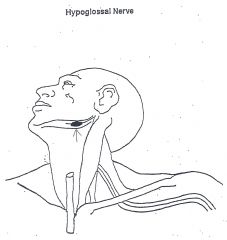
Under the angle of the jaw
|
|
|
Where is the mandibular angle?
|
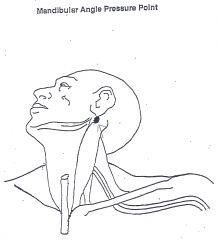
Under the ear lobe
|
|
|
Where is the jugular notch?
|
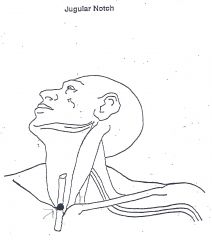
Under the Adam's apple, at the level of the collar bone
|
|
|
Where is the infra-orbital?
|
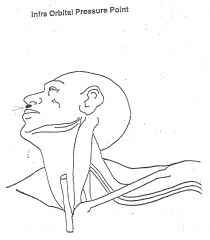
Base of the nose
|
|
|
Where is the brachial plexus?
|
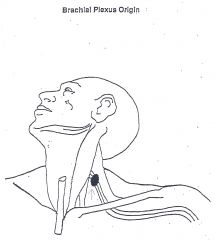
Sides of the neck
|
|
|
Where is the median nerve?
|
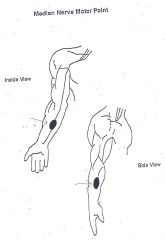
Inside of the forearm at the base of the wrist, just above the heel of the hand
|
|
|
Where is the femoral nerve?
|

Middle of the inside of the thigh
|
|
|
Where is the common peroneal?
|
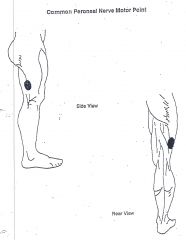
On the outside of the thigh, approximately six inches above the knee
|
|
|
Where is the tibial nerve?
|

Calf muscle
|
|
|
Where is the brachial plexus clavicle notch?
|

Not to be confused with the jugular notch, the clavicle notch is located behind the middle of the collar bone
|
|
|
Where is the brachial plexus tie-in?
|
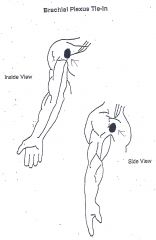
In front of the shoulder joint, where the chest, bicep, and deltoid muscles meet
|
|
|
Where is the suprascapular nerve?
|

On the side of the neck, to the rear, where the trapezius muscles meet the neck
|
|
|
Where is the radial nerve?
|
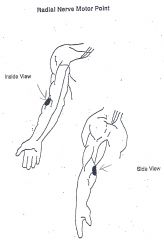
In the middle of the forearm muscle
|
|
|
Where is the superficial peroneal?
|
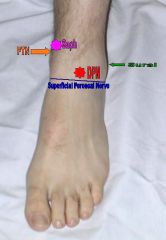
Bottom of the shin, just above the instep
|
|
|
What are the handcuffing techniques we have learned?
|
Handcuffiing standing
Handcuffing kneeling Iron wrist lock takedown |
|
|
What escort positions have we learned?
|
Escort position
Escort position distraction (Knee) Transport wrist lock takedown Straight arm bar takedown |
|
|
What touch pressure techniques have we learned?
|
Pressure points
|
|
|
What striking techniques have we learned?
|
Straight punch
Palm heel strike Backhand brachial stun Palm heel brachial stun Outside forearm brachial stun Inside forearm brachial stun Knee strike Front thrust kick Angle kick (Roundhouse) |
|
|
What blocking techniques have we learned?
|
Outside check
Outside check with radial stun |

